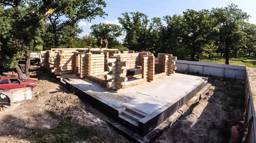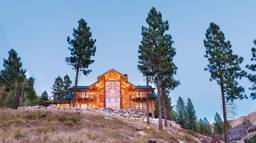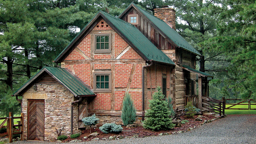
This Montana cabin takes advantage of its sloped lot with a walk-out basement on the backside. See more of this home here. Photo: Joseph Hilliard
Question: My wife and I own property with a gentle slope. I’ve heard it’ll cost a fortune to build up the ground for a slab foundation. Would I save more by building a house with a basement?
Answer:
Slabs and slopes often don’t play well together. It isn’t just the cost; there are other problems as well. Bringing a slope up to level for a slab usually requires building a stem wall or retaining wall on the lower edge of the foundation and adding fill dirt to provide a level base. But be careful: Placing a slab on fill opens the door for cracks and settling. Make sure your builder or excavation team takes great care to compact the fill.
Another issue is drainage. Building codes require that non-masonry building materials be at least 8 inches above the soil surface. I recommend doubling this height to protect log walls from damaging rain and drifting snow. This means adding even more fill. If you’re trying to avoid a basement, consider using a crawlspace. This will require a footing and short wall. If you’re building where winters can be severe, normal footings must be several feet deep.
Also, ask your building about frost-protected shallow footing (FPSF) to reduce the amount of digging and concrete. This building technology has been used in Scandinavia for half a century and provides a more energy-efficient foundation system for less money. As an added bonus, your crawlspace will offer some storage and allow you to run electrical wiring and plumbing—a much easier route than running these through a slab.

Photo: Elk Ridge Builders
Question: What are some pros and cons of building on a slope?
Pros
Building on a slope offers the possibility of a walkout or lookout lower level. This means daylight instead of the dark mustiness of a subterranean basement. Being able to finish all or part of the lower level allows you to build more home for less money.
Sloping lots offer a lot of aesthetic advantages, too. In a forest, a home built on a slope may mean that windows on one side will take in views of a forest canopy and provide a sense of living in a tree house. In more open country, a slope can provide your home with a commanding view of mountains, lakes or meadows.
Cons
Slopes have two potential drawbacks that can cause some anguish to your builder and pocketbook: accessibility and drainage. Steep slopes are difficult to access with the heavy equipment needed to build your foundation. The time required to build your foundation is often increased, and it may be necessary to pump concrete to your foundation. This can mean increased costs.
Sloped home sites also present drainage challenges. If you build at the top of the slope, chances are you won’t face any issues. But if your site is on the side of a slope, you need to pay special attention to the amount of water that can flow toward your home and its foundation. Building codes require that the land immediately around your foundation slope away from it. This may mean your builder has to create a foundation that is partly exposed on the “upslope” side with fill dirt added for a slight counter slope against the house. This step has a positive side: less digging, and the so-called waste soil from excavation may be used as fill.
See also: How to Choose the Best Possible Site to Build

These Ohio homeowners took saw their sloped lot as an opportunity to take advantage of the view. See more of this home here. Photo: Richard Lee
Question: Our lot has a 15 percent slope. Does this type of grade require a special type of home design?
Answer:
A 15 percent slope means that, for every 100 feet of horizontal distance, elevation changes 15 feet. This may not seem like a lot, but let’s consider how building on a slope like this affects your foundation.
Imagine that your home has overall dimensions of 28 by 60 feet. If you orient the house so that the 60-foot dimension is in the same direction as the slope, the lower corners will be 9 feet lower than the upper corners. If you orient the house so the 28-foot dimension is along the slope, the lower corners will be about 4 feet below the upper corners. As you can see, the latter case involves much less digging.
You can easily determine your home site’s slope with some string, a tape measure and an inexpensive “string level”—a small level vial that hangs from the string and is available from hardware stores. Simply stake one end of the string and measure off a distance down the slope with it. Hold the string taut and level and measure the distance from the string and the ground. Transfer this information to a sheet of graph paper and sketch in your foundation to see how the slope will affect your foundation.
See also: How to Pick the Perfect Piece of Land

Photo: Peter Amend, Courtesy of Real Log Homes (See more of this home here.)
Question: Is building on a slope more expensive? Will there be extra excavation costs?
Answer:
Usually, building on a slope requires less excavation than building on a site on level ground. However, if the slope is steep, the excavator may have to do some grading around the side in order to gain access. Also, steep slopes may require the use of more specialized equipment designed to operate in rougher terrain. Steep slopes may require a lot of final grading to re-direct water flow and protect your foundation. This occasionally requires your builder to haul in and spread more fill dirt, which can increase the cost of your foundation significantly.
See also: Your Step-by-Step Guide to Log Home Construction

Photo: James Ray Spahn (See more of this home here.)
Question: We have a 2-acre gently sloping lot in a gorgeous area that’s sometimes prone to mudslides. What major factors should we consider before we build?
Answer:
If you’re in mudslide country, you don’t want to find yourself upon the ground that may slide or be in a mudslide’s path. Study your site carefully to determine where water and mud have gone in the past. If possible, visit your site during a heavy downpour and see what happens to the water. Gentle slopes don’t usually pose a great threat, but building your home on the lip of a steep slope raises the possibility that rushing water may scour under your foundation and send your home sliding. If your building site presents any risk of mudslides, it’s best to talk with a civil engineer or an experienced excavator.

This log home built along a slope takes in 270 degrees of scenic North Carolina wilderness. See more of this home here. Photo: Joseph Hilliard
Question: We want our sloped property to have gorgeous landscaping. What can I do with a sloped lot?
Answer:
Landscaping on slopes requires some attention to detail. First, make sure that the landscaping you have in mind can handle the slope. If some of the plant species you’ve chosen have difficulty establishing their roots in sloped areas, you may want to create a series of retaining walls. The construction of retaining walls is both an art and a science. Not only does it require a feel for the aesthetics of the landscape, but you must understand the forces that affect the wall and the construction required to control them.
Short retaining walls (2 feet or less) are fairly simple, but as the walls exceed 2 feet in height, the weight bearing on the back of the wall makes construction more challenging. It’s important to build the walls to resist the forces of the soil they hold. This may mean extra reinforcement and the use of “dead men,” which are anchors for the wall.
Sloped lots usually offer a world of design and building possibilities. If you plan correctly and work with your builder to properly map out and excavate your home site, you’ll get the best of both worlds: an efficient home plan and some amazing views.
See also: Five Tips to Hardscaping Your Property

Photo: Southland Log Homes (See more of this home here.)
Seven Quick Tips for Success When Building on a Slope
- Create a daylight basement in the excavated wedge area under homes on the downside slope. You’ll create a great view with an additional room, instead of an underused crawl space, and without enlarging your home’s footprint.
- Reverse your layout. Sloping sites allow a more modest appearance from the front and a grander one from the rear, especially with dramatic windows, such as prows. When building on a slope, it is often best to put your “front” door behind the house.
- Have your driveway access the home from above, not below. You’ll avoid having to cut the driveway into the side of the hill and build retaining walls to keep dirt and stone from falling onto it. Placing your garage at the front of the top level opens up views at all levels in back of the home.
- Build tall. Taller homes with smaller footprints require less excavation and grading, both of which are major construction expenses. And a narrow, stacked house with an open floor plan can bring views to all or most rooms.
- Avoid building on the very top of a hill or mountain. A panoramic view is great, but it will also raise your heating costs by exposing the home to cold winds in winter. Use the slope to shelter the house and narrow the view’s focus.
- Properly site your home. Site your house to avoid winter shade and summer sun as much as possible.
- Make the house part of the view. Build to conform to the land’s contours, and blend rather than clash with the topography.
Learn more about building on a slope:











